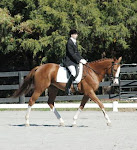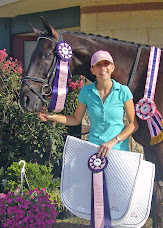Danielle from Oregan asked: "My horse had a hoof abcess around Christmas time and my vet and farrier didn't agree on whether or not to soak the hoof - the vet said "yes" to draw it out, and the farrier said "no" it would just soften the hoof and not really help. What is your opinion on the subject?"
Arvin Reynolds answers:
"My general rule of thumb is - don't soak it until you have a track- that is - an area where the vet or farrier has dug out the abcess or where the abcess is naturally rupturing. Applying an ichthamol poltice to this area and wrapping the hoof is a good way to continue to draw the infection out in between soaks.
If you start soaking the hoof before you have visible evidence of an abcess you soften the entire hoof structure, thereby making the hoof more vunerable to bruising - this negative effect, in my opinion, does not justify what little benefit soaking the hoof may have inasmuch as bringing out an abcess. I have seen many cases where premature hoof-soaking has confused the issue rather than helped - for example - during the shoeless and soaking regimen, the owner takes the horse for a walk, the horse steps on something or overuses himself, becomes sore-footed and possibly bruised, then the owner/vet is unsure of whether an abcess is really developing or if the horse is just sore, and unnecessary time is wasted.
My advice, if you suspect an abcess is brewing, allow the horse as much turnout as possible to keep blood circulating and wait patiently -resist the urge to give bute or pull the shoe too soon. If there is an abcess, there should be a pocket of heat developing as well. The horse's lameness should be gradually and clearly getting worse. Anything else is more likely a stone bruise or heel soreness. If you're horse was just shod, perhaps it's a too-close trim or a close nail. But please consult your farrier before soaking the hoof, and never soak with the shoe on."
Arvin Reynolds is an AFA, BWFA and Cytek certified Farrier specializing in therapeatic shoeing. His practice is in the Mid-Atlantic and southern FL (winters only). He can be reached at 703-895-4786 and AGRShoeing@aol.com
Saturday, February 16, 2008
Ask the Farrier - Should You Soak a Hoof Abcess?
Friday, February 15, 2008
Ask the Farrier Friday - Should You Soak a Hoof Abcess?

Thursday, February 14, 2008
Two Horses Die After Freak Collision in Pasture
Wednesday, February 13, 2008
Winter Grooming Tip - How to Cool Out a Sweaty Horse on Cold Day
 If you are training hard this winter, and weren't so fortunate to clip your hairy beast, you've experienced the challenge of drying and then grooming a long coat encrusted with sweat and dust. Here's the method that's worked best for the Good HorsePerson:
If you are training hard this winter, and weren't so fortunate to clip your hairy beast, you've experienced the challenge of drying and then grooming a long coat encrusted with sweat and dust. Here's the method that's worked best for the Good HorsePerson:
After the horse's respiration has returned to normal or pretty close - before the horse dries -spray her down with a generous coating of dry shampoo spray (try Cowboy Magic Green Spot Remover/Shower in a Bottle) and immediately cover her with a breathable cooler (polarfleece works well). Then, peel the cooler back in sections to rub the shampoo into the coat with a towel or rag that has a good nap to it. After the rub-down, you can stall the horse, still wearing the cooler, to finish drying. He will dry much faster after all your rubbing and with the help of the shampoo, his coat won't be so crusty and swirled. If you're worried about the horse rolling and getting tangled in the cooler, a dirty, unrolled polo wrap tied around the horse behind the elbow makes a quick surcingle. After 20 minutes or so, you can remove the cooler and brush the hairs back in the natural direction of hair growth so the coat is smooth - especially important if you're blanketing. All done!
Tuesday, February 12, 2008
Tips for Selling Your Horse Online from Equine.com
Check out these five simple tips for selling horses online courtesy of http://www.equine.com/
1. Make sure your contact info is up to date. You always want to be sure that potential buyers can contact you in the most efficient, best possibly method. If you check email frequently, make sure the address is correct. If you use a phone number, make an effort to check voice messages if you miss calls.
2. Submit high quality photos and videos that reflect your horse's best features. Text ads are quick, but the best proven way to sell your horse is to upload a photo or a video. It increases your potential for serious buyers since they are more apt to choose a horse based on what they see in a photo rather than a plain text description.
3. Honesty. While you want to show your horse in the best possible light, you also want to be forthcoming about any vices or training issues he may have. This lets prospective buyers know what issues could occur with the horse, and garnishes more trust in you as a seller.
4. Title your ads with pizazz! They say it's the sizzle that sells the steak. Get that horse noticed by putting your horse's best attributes right into the title. What's he known for -- is he quiet? Bombproof? Use it in the title!
5. Patience is key. Sometimes it takes hours or days, and sometimes it takes weeks or months. Know your market, price your horse fairly, and with a little bit of patience, your efforts will pay off.
A word of advice on photos from the Good HorsePerson - take your photos on a sunny day, with the most picturesque possible background - take lots and lots of them. Then print them out four to a page and show your trainer, your barn manager, any one you can find and see what strikes them the most - then edit your collection ruthlessly and only send the cream of the crop to propective buyers.
Monday, February 11, 2008
Horse Health Tip - How to Spot an Ulcer or Other Digestive Problem
 The stresses of the domesticated horse, especially the competition horse are many. You may have noticed an explosion of equine digestive medicines and supplements on the market lately - for good reason - but don't implement them just for the heck of it. Here's a few of the more concrete warning signs that your horse could be developing a digestion problem:
The stresses of the domesticated horse, especially the competition horse are many. You may have noticed an explosion of equine digestive medicines and supplements on the market lately - for good reason - but don't implement them just for the heck of it. Here's a few of the more concrete warning signs that your horse could be developing a digestion problem:
1) Change in attitude towards work, i.e. a normally willing horse becomes reluctant, stubborn and yet appears to be sound
2) Change in appearance - a dull coat, listless eye, failure to shed out normally
3) Repeated bouts of colic or tying up
4) Visible amounts of grain in manure (note - for horses on sweet feed or other whole grain feeds a little grain in the manure is normal)
5) Overly stressed at feeding times - especially after eating.
The focus on digestion's effect on the performance horse is still a relatively new emphasis in overall care - if you feel your vet isn't making the connection you are, it's probably best to get a second opinion. Don't forget to talk to your barn manager whenever you notice a change in behavior and/or temperament. Often he or she has noticed something out of the ordinary and just needs prompting to talk about it - the best plan is to catch him/her at an off-peak time to chat.







